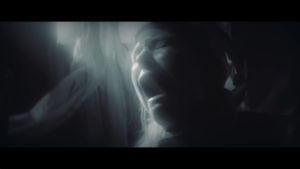“c”
Writer/Director Anders Elsrud Hultgreen brings us “Septichexen” from Norway, and since I don’t speak Norwegian, I turned to Google Translate to shore up my sense of the title—The Septic Witch, The Sewer Witch, The Witch of Infection, possibly also a sense of Septic Shock. All these senses work with a film about a young female microbiologist investigating the sewers beneath the city of Bergen for the cause of widespread waterborne illness. She finds the apparent cause in the forms of witches and gets pulled into their workings, which might implicate the whole planet.
The story, though pleasantly bizarre and a possible vehicle for environmentalist reflection, takes a backseat to just under fourteen minutes of visual and aural poetry. The film’s visual style is perhaps most striking. The image quality along with extensive use of vignetting and natural framing to direct the viewer’s eye suggest early film, especially the silent era, a suggestion backed up by a limited color palette like those used in Expressionist films. “Septichexen” might especially recall Häxan (1922), another Scandinavian film about witches and an important milestone of silent horror that uses some comparable visual strategies. For a film buff, the result is pure eye candy, delicious because beautifully executed by Hultgreen, Thomas Dalen, and likely many other contributors to the cinematography and overall look.

Although it visually recalls the silent era, the film is emphatically not silent, even though an intertitle introducing the situation early on seems to point in that direction. Once the action starts, the sounds of dripping water, which the intertitle has told us carries disease, makes threats seem ubiquitous. The microbiologist’s footsteps echo as she descends through sewer levels, providing an imposing sense of space. The dripping water and changing colors as she descends recall another, much later classic of European witchery—Italian filmmaker Dario Argentio’s Inferno (1980)—and the sounds, with ever-more-unnerving music by Hilde Annine Hasselberg, do help to suggest that, like Argento’s exploring heroine, the microbiologist might be getting in over her head.
The witches she eventually finds add to the soundtrack a literal kind of poetry, both exposition related to the story and commentary on the nature of existence. They talk about poisoning the water, but somehow that relates to broader comments about volcanic eruptions, desolation, isolation, and death. One witch comments, “You are nothing more than rotting flesh in the middle of life, Life, the disease that causes death.” The witches also quote from the Book of Revelations, suggesting that what’s happening with the water has more cosmic, apocalyptic significance. I’m not sure what they say all makes sense together, but it’s all very dark, disturbing, and fascinating.
The visual poetry gets a boost during the recitation of the oral poetry from images of the witches’ tools, some modern vials and other implements, some arcane and ancient, most horrific-looking. We also see various cauldrons full of swirling brews that are sometimes mixes of skulls and gore and sometimes like animated abstract paintings, filling the screen with unctuous shapes. Perhaps most powerful are images of the microbiologist reacting with anguish to the witchery she observes.

“Septichexen” is art horror, if that means anything to you, but it’s a sensory feast, definitely worth the small time investment and likely to stay with you.
Reviews of Top Horror Film Shorts for MiSciFi
L. Andrew Cooper, Ph.D.
https://landrewcooper.com